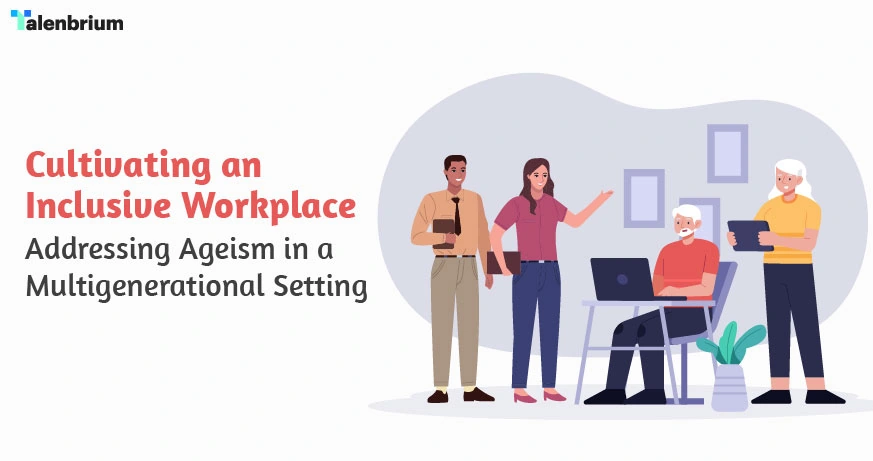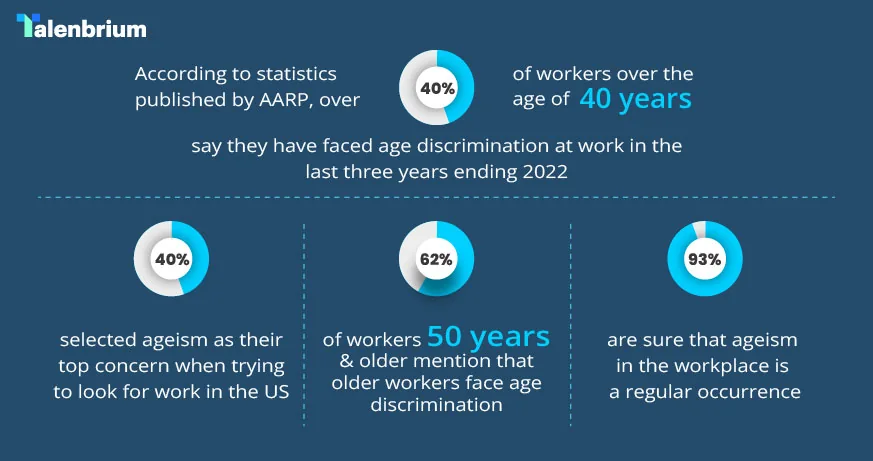Contact Us

This further highlights the fact that challenges that exist in the working world today are not only haunting the older individuals, but are trailing the younger ones as well.
Ageism may not be easily noticed or by majority of employees or coworkers or even show the slightest evidence of presence in any organization or company, but it has been having some negative impact in the multigenerational workplace since late. While aging employees and workers may be slowly sidelined in some organizations and companies as they reach a certain age, the matter is steadily coming to the fore. A number of surveys have indicated that workers or employees over a certain age are no longer being delegated tasks they were responsible for earlier and some see the reasons for not being included in the loop such as ‘out of respect for seniority’, because timelines are tight, or as there are newer and more capable individuals on board belittling or even overwhelming.
For many, ageism is creating rising concerns and stress, and younger employees and those closer to the ‘uncomfortable years’ are unconsciously preparing for going through these ‘uncomfortable times’. Not to be overlooked though is the fact that ageism and age-bias is not limited only to employees who are older, as the number of younger professionals facing a similar situation in the workplace continues to increase.
Discrimination or unfair treatment of individuals on the basis of their age can have a negative impact on overall workforce, irrespective of younger or older, senior or mid-level, or junior employee. Over time, if a company is assumed to be indulging in hiring bias, implementing restrictions on promotion and training opportunities, stereotyping, marginalization, or impressing retirement pressures, such companies run the risk of also being stereotyped or profiled for following allegedly unfair practices.
It becomes evident when some employers highlight preferences in advertisements or posts seeking applicants and candidates within a specific age group, rejecting applications of older individuals despite them possessing relevant experience and skill sets, overlooking older employees for promotions or training opportunities based on the assumption that they are lacking ability to adapt to new technologies or more modern work ethics, harboring perceptions that older individuals have fixed work habits and lack learning abilities, or age is hampering productivity and such individuals lack motivation and ambition. Other relevant indications include older employees being marginalized and not being included in activities and projects that younger individuals are being tasked with, unfair judgement with regard to minor workplace misunderstandings, and pressures to resign or retire.
On the flipside however, while older individuals may be sidelined and tasks handed to younger employees, the younger employees face skepticism about their capability and experience. Older workers are not the only ones enduring age bias, and ironically, workers between 18 and 34 years of age are also 13% more likely to face age-based discrimination in the workplace than workers 55 years and older. However, the factors and consequences of ageism that older workers must consider are not necessarily the same as younger professionals need to, but the scenarios place all employees in a dilemma.
Besides having to consider age as a physical and mental stumbling block to potentially limiting further acceleration along the career ladder and gaining more recognition, older professionals aged 50 years and above are expected to be more likely to face age-based discrimination than their younger counterparts. That is not a reality however, as survey results indicate otherwise. According to a survey, 15% of respondents indicated that they would not want a boss who was 70 years of age, while three-times that said they would not want a boss 30 years old. This further highlights the fact that challenges that exist in the working world today are not only haunting the older individuals, but are trailing the younger ones as well.
Though analysis of collective employment data indicates that most companies consider age a factor and younger workers or job applicants are preferred over older ones, aging individuals account for a significant share in the job applicant pool globally. According to research results from American Association of Retired Persons (AARP), individuals aged between 55 and 64 years who had left the workforce have rejoined at higher rates than younger age groups between 2020 and 2022. This also translates to 13% of older persons in the US still working or looking for work while considering themselves retired.
Also, around 39% of 2014 retirees assert that they were forced to retire by their respective organizations, and this is significantly higher than the same reason declared by retirees (26%) in 1998. According to a number of participants in the AARP survey, later stages of life does not mean that one has to give up their ambitions and work ethic, yet businesses continue to ‘push’ older members of the workforce out of their jobs. Going by the obvious, it is clear that ageism in the workplace has gained momentum in more recent times and is making it even more challenging for older workers to start afresh when seeking another position.
As the world proceeds into a more real-time scenario and almost all things are virtually globalized, information and news can be put out there in the blink of an eye. Individuals are more active virtually and socially than ever before, and employee-driven platforms, forums, social media platforms, and apps make it that much easier to reach peers and the general public almost instantly. A number of companies have and continue to face issues and bad publicity and trolling for reasons that may have been actual or genuine, or fabricated or falsely created by employees or individuals with vested interests. While there may be dozens of instances or reasons for such negative remarks or publicity for companies, ageism is one that has been gaining rapid attention in the recent past.
Regardless of the approaches companies or skeptics agree are being deployed or not, or reasons for older employees being sidelined or not being included, continue to be debated on social media and other platforms, the general challenges older workers face are apparently real as they grapple with ageism in the workplace.

Delayed retirement could be seen as a key factor for older or aging workforce, and this varies from country to country. In most countries for instance, the effective retirement age is between 60 to 65. Japan and Korea are exceptions with effective age of retirement nearer 70 years for men, while women in general, retire around one to two years earlier than men. While the primary reasons could be anything from late entry into the corporate arena or working world to late retirement age, the fact remains that ageism is a pertinent issue to be addressed to foster an inclusive work environment confronting ageism and prospects of a multigenerational workplace.
Addressing ageism can be initiated through the creation of inclusivity and a workplace culture that values an employee or team member according to experience and skills, and proven capabilities and contributions, rather than concluding based on the age factor. Implementation of policies and programs internally in companies to promote equal opportunity, training and further opportunity for growth, diversity and inclusion, and integrating and fostering collaboration across all departments are essential in combatting ageism and age-bias.
A step to combat pretentious assumptions that anyone might have that a company or organization is a hotbed for ageism is to create inclusivity. Welcoming individuals from different backgrounds, identities, or ages into a common setting or platform as equal and valued team members is a way to define inclusivity more easily. An inclusive work environment creates and holds high morale, enhances happiness quotient, and helps to spawn new and highly productive ideas and innovation, diverse approaches, and solutions. Besides, inclusivity also encourages diversity across a company and drives productivity and loyalty.
Initiating anything new that is not part of a known set of processes at any workplace can be challenging to understand or relate to, let alone remember and follow as part of the work culture. Feedback is highly valued as a means to create, maintain, and continue a process, and this can be fortified by open line of communication between employees and concerned department such as Human Resource Management (HRM) and others. In some work settings, or on basis of type of job and expected age of employee and norm according to current day scenarios, it may seem out-of-place to have an older individual performing a task that is assumed to be more suited for a much younger individual. Such situations can create bias or misunderstanding and lead to confrontation or disagreement. However, as mentioned earlier in this article, companies are realizing the importance of experience and skill over youthful vigor for specific tasks and jobs, and bias is a major practice that is being adulterated or being done away with slowly. A number of companies are overcoming such barriers by extending part-time or remote work policies for older employees and focusing on ensuring business goals are met unhindered. This can serve to resolve short-term challenges, but would need a more thought-out approach and planning to ensure more direct focus on creating inclusivity and confronting ageism, and fostering a multigenerational workplace.
It appears that ageism and age-bias can be a double-edged sword as age waits for no one, regardless of designation or type of skillset and experience one brings along. Currently, more individuals and working professionals are raising concerns related to the need to have a more diverse future to look forward to. This is more inclusive for tech workers in tech companies and entrepreneurs of startups to be able to function within their respective industries, regardless of age and related restrictions and bias. As age overlaps with areas such as gender and race, having only 8% of all diversity and inclusion programs considering age to be a core component seems unacceptable.
For example, youth along with technology and innovation are more than often paired, and which is unanimously regarded as a false narrative. Going by confidential administrative data sets from the U.S. Census Bureau, a team of Harvard Business Review (HBR) researchers have concluded that the average age of entrepreneurs at the time of founding their company was 42 years.
In addition, according to ‘Age and High-Growth Entrepreneurship,’ which is a research paper published in the American Economic Review: Insights journal, older entrepreneurs tend to do better, and the four economists opine that a 60-year-old who starts a new business is three times more likely to succeed than a 30-year-old peer. Hence, if the age to succeed is closer to the uncomfortable period of work life, it would seem unfair to have policies that restrict employees and workers from continuing or being sidelined based on age as a factor.
If more companies continue to claim to be disruptors and include inclusivity and diversity as part of their work culture, it certainly makes sense that they should break away from biased practices and combat ageism and other forms of ableism to drive brand value and image. Also, as more companies recognize and understand the value of each employee and team member and build more open-minded spaces where older workers are welcome, it will allow all workers to reenergize and reignite ambition and drive with keener focus on helping to achieve company and organization goals.
Your email address will not be published. Required fields are marked *